Blätter für Kakteenforschung 5, 1934
Tělo jednotlivé, kulovité, až asi 15 cm v průměru, matně světle zelené. Žebra asi 10, středně široká, rozdělená v nízké hrbolce. Areoly asi 6 mm velké, zpočátku hustě bíle plstnaté, později zcela zčernají.
Okrajové trny asi 7, lehce masově zbarvené, poněkud zahnuté a jeden až 3 cm dlouhý, směrem vzhůru ohnutý střední trn.
Květy porcelánově bílé, polootevřené, se zeleným jícnem. Plod kulovitý. Semena matně černá.
Domovina: Severní Argentina, u Mazanu. Později změněno na Catamarca podle Stümera.
Backeberg rostliny koupil u Stümera, obchodníka s kaktusy v Buenos Aires. Autor popisu několikrát popis upřesnil, tak jako v jeho Die Cactaceae III: barva těla sametově modrozelená, pod hrbolci jsou hluboké příčné rýhy, areoly zpočátku se žlutohnědou plstí, trny jsou růžově šedé v počtu 7 – 8, střední trn má být delší než 3 cm.
Jméno nigriareolatum znamená „s černými areolami“ a takto přicházely i importy. Semenáčky však měly areoly vždy bílé, časem sešedlé, ale v kultuře nikdy černé. Zda šlo o znečištění či napadení houbami na nalezišti, není známo.
Frič sbíral tyto rostliny také a pojmenoval je Gymn. curvispinum, ale k popisu nedošlo. Rostliny byly uvedeny ve Fričově prodejním katalogu Der Kakteenjäger roku 1929 pod dvěma údaji, Gymn. curvispinum Catamarca a Gymn. curvispinum Portezuelo, a takto se tyto rostliny vyskytují ještě v našich sbírkách. Kreuzinger označil Gymn. nigriareolatum za synonym Gymn. curvispinum. Dr. Schütz uvádí, že tyto dva taxony se ale liší barvou jícnu květu, že Gymn. curvispinum má jícen růžový, Gymn. nigriareolatum má mít jícen zelený (podle popisu). V pozdějších letech pak nabízela firma Karlheinz Uhlig semena Gymn. curvispinum acuticostatum (resp. angusticostatum), o původu mi ale není nic známo. Pěstoval jsem velkou skupinu různých forem Gymn. nigriareolatum a curvispinum, ale s přibývajícím věkem a velikostí rostlin se rozdíly ztrácely, všechny rostliny měly nažloutle šedě plstnaté areoly, květy byly nápadně uniformní, jícny převážně více nebo méně růžové, a pozorovatel při troše pozornosti našel i květy s nazelenalým nádechem jícnu. I z toho je zřejmé, že jde o jeden a tentýž taxon.
Další nálezy: RF 102 El Portezuello; HU 1626 Catamarca; LB 1235 Las Pirquitas, LB 1239 La Puerta, LB 1238 dtto, LB 1170a Cuesta el Portezuello, LB 1169 dtto, LB 1174 dtto; STO 254 Catamarca, STO 362 průsmyk na Sierra Ancasti, STO 619 El Bolson, STO 620 dtto, STO 753 El Portezuello, STO 855 La Puerta, STO 253 Merced, STO 268 El Portezuello, STO 363 dtto, STO 788 před dtto; Bo 109a Los Varelas; JS 149 Cuesta de Portezuello; LF 71 Monte Potrero, LF 72 Cuesta de Portezuello; P 132; HV 339 Cuesta de Portezuello; WP 95-238/503 dtto, WP 95-239/504 dtto; JL 33 Monte Potrero, JL 34 El Portezuello; KH 380 j od Villa Catamarca; SE 30 El Mirador; VS 128 El Portezuello; JO 1062.01 dtto, JO 290 Cuesta El Port., JO 164 El Port., JO 330 El Mirador; Tom 063/1 Cuesta de Port; MS 102 El Portezuelo
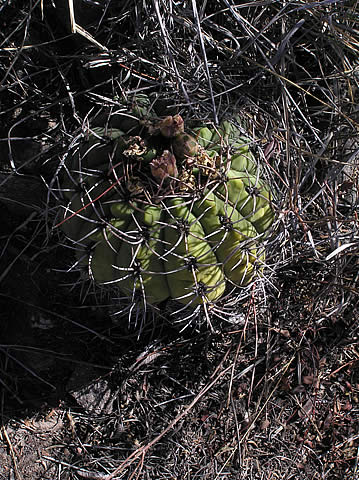
Gymn. nigriareolatum, foto Rudolf Frélich
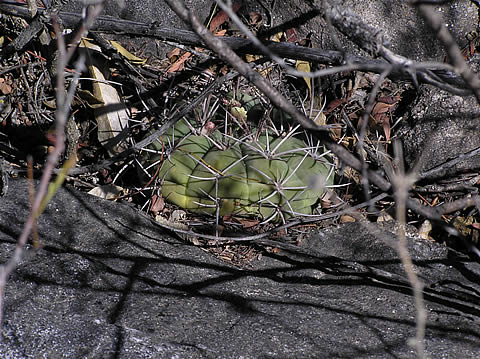
Gymn. nigriareolatum, foto Rudolf Frélich
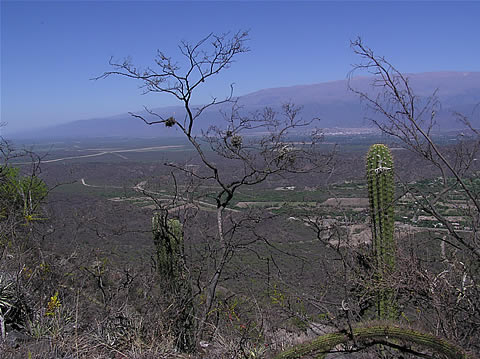
Okolí naleziště Gymn. nigriareolatum, foto Rudolf Frélich

Stanoviště Gymn. nigriareolatum, foto Rudolf Frélich
Gymn. nigriareolatum var. densispinum Backbg.
Die Cactaceae III, 1759, 1959.
Liší se od typu daleko hustějšími, poněkud tenšími a delšími trny, které rostliny silně obalují; počet žeber může být až 15.
Další nálezy: P 24 Dique de Catamarca.
Gymn. nigriareolatum fa. carmineum H.Till
Gymnocalycium (Rakousko), 1998
Má se lišit od typu karmínově červenými květy.
Domovina: Argentina, Catamarca, východ Sierra de Ancasti, 600 – 700 m n.m.
K popisu nemůže být výhrad. Skutečnost je však taková, jestliže vysejeme semena tohoto taxonu, 3 jedinci pokvetou krásně červeně, 5 jich pokvete čistě bílými květy jako u typu.
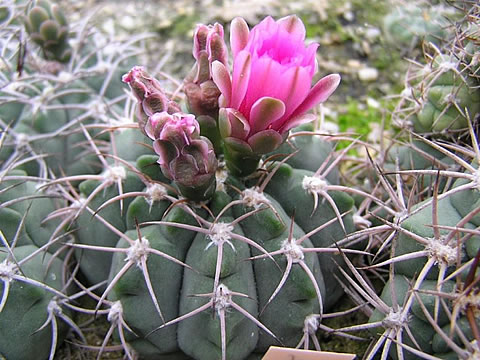
Gymn. nigriareolatum carmineum, foto Rudolf Frélich
Gymn. nigriareolatum var. simoi H.Till
Gymnocalycium (Rakousko) 1998
Liší se od typu krátkými, silnějšími, k tělu silně přiléhajícími, jakoby plstí potaženými, bělavými trny, u starých rostlin se může vyskytovat tuhý, téměř přímý střední trn, jakož i většími květy.
Domovina: Argentina, Catamarca, Palo Labrado (mezi Portezuello a La Merced).
Další nálezy: GN 939 Catamarca; VS 126 Monte Potrero; P 39.
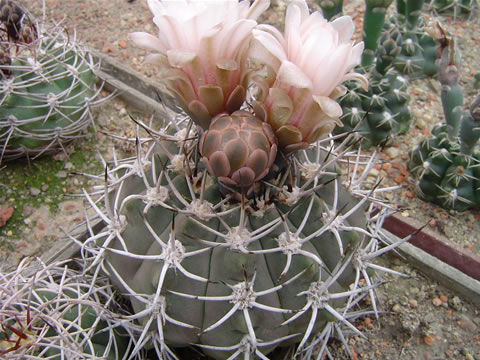
Gymn. nigriareolatum simoi
Gymn. nigriareolatum – summary:
Backeberg had bought the plants at the cactus businessman Stümer in Buenos Aires. The author of the description has made several times more exact description, like in his work Die Cactaceae III: the colour of the body velvet bluegreen, the transverse cuts are under protuberances, areoles with yellowbrown felt at first, spines pink gray, in number of 7 – 8, the central spine ought to be longer than 3 cm.
The name nigriareolatum means „with black areoles“ and also imported plants have come like this. However, seedlings had areoles always white but never black in the culture. It is not known if it has been some contamination or fungus attack of the finding place.
Frič had also collected these plants and he had named them Gymn. curvispinum but a description has never appeared. The plants were mentioned in Frič´s selling catalogue Der Kakteenjäger 1929 under two names, Gymn. curvispinum Catamarca and Gymn. curvispinum Portezuelo, and the plants with these names occur in our collections else. Kreuzinger had marked Gymn. nigriareolatum for the synonym of Gymn. curvispinum. Dr. Schütz has mentioned that these two taxa differ with the colour of the throat, that Gymn. curvispinum has pink throat, Gymn. nigriareolatum ought to have green throat (after the description). The firm of Karlheinz Uhlig has offered in the following years seeds of Gymn. curvispinum acuticostatum (resp. angusticostatum) but I have not known anything about an origin. I have grown the big group of various form of Gymn. nigriareolatum and Gymn. curvispinum, however, the differences have been lost with bigger size and age, all plants have yellowish gray felt in areoles, the flowers have been strikingly uniform, the throat mostly more or less pink, and the observer can find with few notice even the flowers with the greenish tinge of the throat. Even from it it is evident that it is one and the same taxon.
Gymn. nigriareolatum var. densispinum. It differs from the type with much more dense, rather thinner and longer spines, which plants pack strongly; the number of the ribs can be to 15.
Gymn. nigriareolatum fa. carmineum. It ought to differ from the type with carmine red flowers. Homeland: Argentina, Catamarca, east of the Sierra de Ancasti, 600 – 700 m. It coulb be no reserve with the description. However, the reality is that – if we sow the seeds of this taxon, 3 specimens will flower nice red, 5 specimens with clear white colour like the type.
Gymn. nigriareolatum var. simoi H.Till. It differs from the type with short, stronger, to the body strongly pressed, like if felted coated whitish spines, there can occur rigid, nerly direct central spine on the old plants, and also with bigger flowers. Homeland: Argentina, Catamarca, Palo Labrado (between Portezuello and La Merced).
